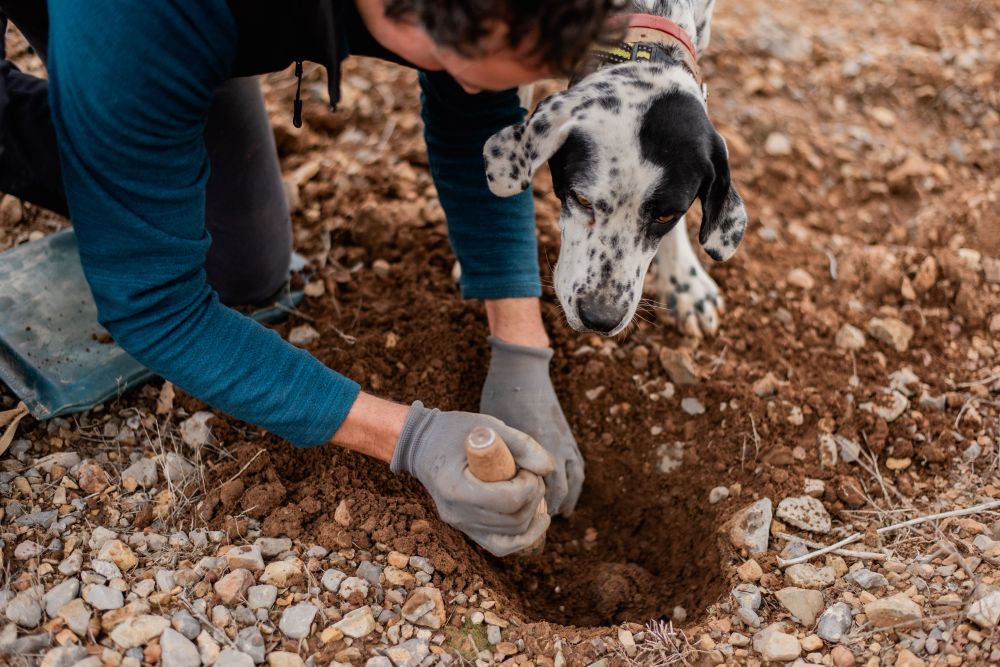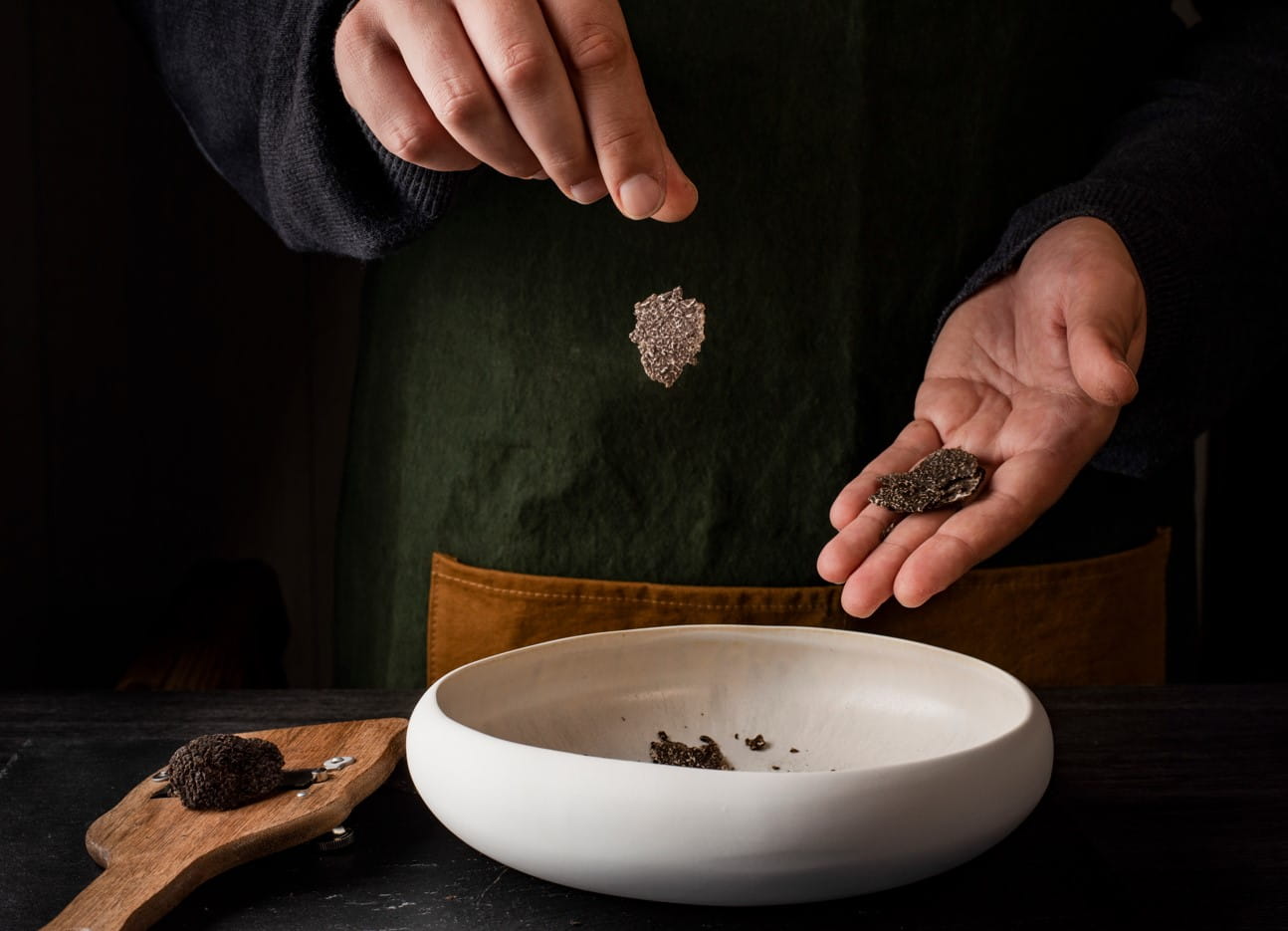The black truffle (Tuber melanosporum) is undoubtedly one of the most coveted treasures in the world of gourmet gastronomy. This gourmet mushroom not only stands out for its intense flavour and pungent aroma, but also for its excellent ability to transform the simplest dishes into culinary delights. A simple slice on a fried egg or a traditional Italian egg pasta dish can turn a homemade recipe into a creation worthy of a Michelin-starred restaurant.
In fact, they are frequently used in warm salads, homemade pizzas, cured cheeses or even in some types of desserts. However, its high market value is not only due to its organoleptic qualities, but also to its limited production and the effort required to cultivate and harvest it.
The black truffle is only able to thrive in regions with very specific climatic conditions in Italy, France and Spain, as is the case in the area around Sarrión, in the province of Teruel. However, we humans do not have such developed senses to be able to locate them or to know when they are ripe enough to be harvested. Precisely for this reason, in this article we would like to talk about the fundamental role played by the truffle dog in the harvesting process of this wonderful gourmet fungus.
Characteristics of the cultivation of the black truffle (Tuber melanosporum Vitt)
In order to cultivate quality black truffle, it is necessary to previously inoculate the roots of certain tree species with spores of the fungus. This process is carried out before planting the tree in the field and requires a soil rich in lime, with a certain pH, good drainage, adequate depth and stable climatic conditions. From then on, truffle growing requires patience, as it can take five to eight years before the first truffles appear.
The symbiosis between the fungus and the roots of the truffle tree – it can be oak, holm oak, hazel or kermes oak, among many others – slowly begins to develop underground. Black truffles ripen at a very specific time, normally between November and March, extending in some seasons until the first days of April.
They grow several centimetres below the surface, which makes it impossible to detect them with the naked eye and, as we have said, the human sense of smell is not developed enough to detect them either. This is where truffle-growing’s great ally comes into play: the truffle dog. In fact, we must point out that, without this type of animal, it would be impossible to detect them at the perfect moment of ripening.
Can dogs find truffles?
Although in the past, trained pigs were used to detect ripe black truffles, nowadays this practice has been almost completely replaced by the use of truffle dogs. The reason? Their ease of training, obedience and greater control when digging. In fact, dogs have a much better sense of smell than humans.
That is to say, while we can barely perceive the aroma of the mushroom once it has been dug up, a truffle dog is capable of detecting its persistent fragrance even when they are underground, at the right moment of ripening. But not all dogs possess this ability. Among truffle dogs, there are certain breeds that, due to their physical and cognitive qualities, are better suited to this type of training. In fact, the success of the process depends as much on the animal’s sense of smell as on the consistency of its training.
How do dogs find truffles?

The process is as meticulous as it is fascinating. From puppyhood, we must train truffle dogs to recognise the unique aroma of the black truffle, positively associating it with a reward. As this fungus matures, the dog learns to locate it under the ground, even in the most adverse conditions . When it detects the presence of the fungus, the dog instinctively starts digging, pointing to the exact spot where we must continue digging to unearth this exquisite fungus.
At that moment, the truffle hunter must act quickly and delicately, using a small tool, called a “truffle shovel” or “truffle picker”, to extract the fungus without damaging it. It is important to intervene before the dog reaches the fungus, as it could end up damaging the truffle. It is precisely this mutual work between animal sense of smell and human expertise that allows the harvesting process to be efficient and respectful of the natural environment.
What are the best truffle dog breeds?
When we talk about truffle dogs and the different breeds, the Lagotto Romagnolo is usually the first one that comes to mind. This medium-sized, sociable and curly-coated Italian breed has historically been bred to gather truffles. It has exceptional scent sensitivity and an obedient attitude, making it one of the most effective truffle dogs. For interesting facts we recommend reading this article on truffle dogs.
The Springer Spaniel and the Cocker Spaniel are also among the most commonly used truffle dog breeds in truffle farming. They are intelligent, active dogs with a great capacity for concentration. Their hunting instinct makes them particularly sensitive to the smell of this gourmet mushroom.
The German Shepherd and the Border Collie, although better known for their herding skills, are also used as truffle dogs because of their obedience, intelligence and physical endurance, although they require more thorough and complex training. The Beagle, on the other hand, has one of the best noses in the animal kingdom, although it tends to be a more temperamental and disobedient breed.
Even the Poodle, provided it is trained from an early age, can also become a good truffle dog thanks to its agility and excellent sense of smell. At Trufalia, a company located in Sarrión and specialised in the sale of top quality fresh and preserved black truffles, we know perfectly well that the world of truffle growing hides a story of tradition, dedication, patience and a lot of complicity between the dog and its guide.











